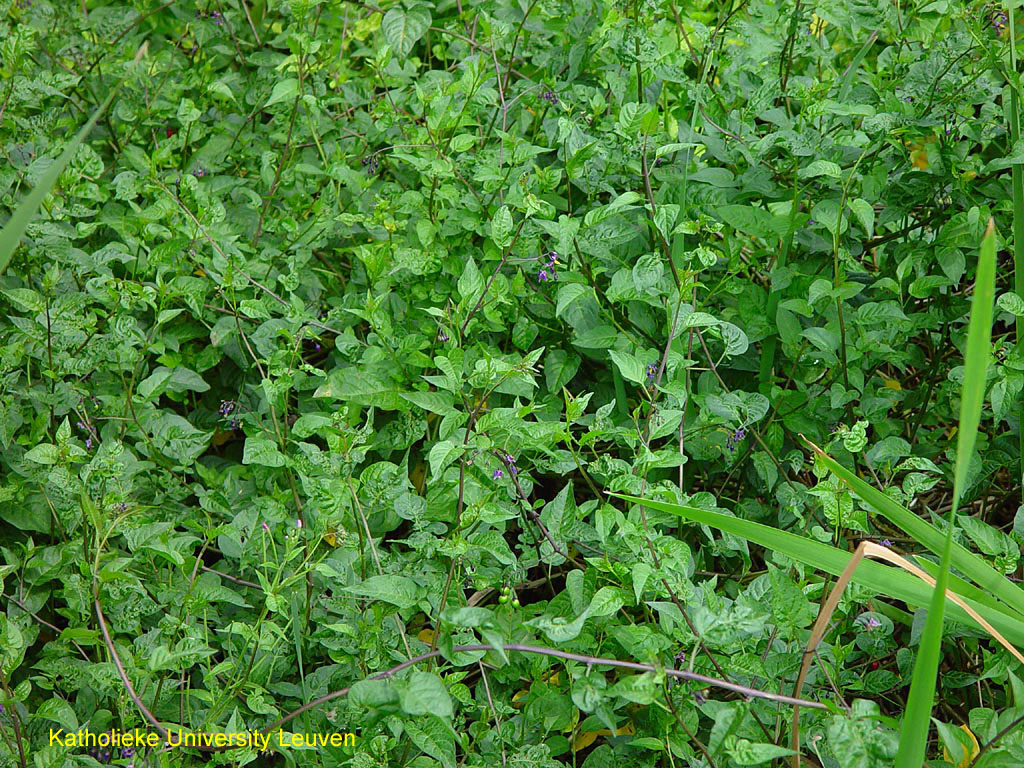Bittersweet nightshade identification and control
Solanum dulcamara, Solanaceae Family

Bittersweet nightshade is a slender perennial vine or semi-woody shrub found throughout King County, especially in creeks and wetlands, as well as field edges, gardens, parks, and roadsides. This plant is toxic to people, pets, and livestock. Leaves are dark green to purple-tinged. Mid-May to September, produces star-shaped purple flowers with stamens fused in a prominent yellow cone. Flowers followed by round or egg-shaped berries that ripen from green, to orange, to bright red. All stages of berry can grow on same plant. Spreads by seed, as well as stem and root fragments.
Legal status in King County, Washington

Bittersweet nightshade is not on the Washington State Noxious Weed List and property owners are not required to control this plant. However, in King County, it is classified as a Weed of Concern and control is recommended, especially in natural areas that are being restored to native vegetation and along stream banks where nightshade can interfere with fish habitat.
For more information about noxious weed regulations and definitions, see Noxious weed lists and laws.
Identification (see below for additional photos)
- Perennial vine or sprawling shrub; lower stems woody, upper herbaceous branches die back each year
- Flowers have star-shaped, purple, backward-pointing petals and stamens fused in a prominent yellow cone; grow in clusters along branches on short stalks extending out from the stems
- Berries are round or egg-shaped and bright red when ripe with numerous yellow, flattened seeds; unripe berries are green
- Leaves are dark-green to purplish and often with one or two small ear-like lobes near the base, leaf blades are 1 to 4 inches long
- Main root grows horizontally just below the surface and suckers frequently
- Crushed leaves and bark have an unpleasant smell
Toxicity
Although this is not the same plant as deadly nightshade or belladonna (an uncommon and extremely poisonous plant), bittersweet nightshade is somewhat poisonous and has caused loss of livestock and pet poisoning and, more rarely, sickness and even death in children who have eaten the berries. Fortunately, bittersweet nightshade has a strong, unpleasant odor, so most animals will avoid it, and poisonings from this plant are not very frequent.
The entire plant contains solanine, the same toxin found in green potatoes and other members of the nightshade family, and it also contains a glycoside called dulcamarine, similar in structure and effects to atropine, one of the toxins found in deadly nightshade. The toxin amount varies with soil, light, climate and growth stage. Ripe fruits are generally less toxic than the leaves and unripe berries, but even ripe berries can be poisonous.
Habitat and impact
Bittersweet nightshade is very common in King County and found everywhere from backyards to pastures, creeks, roadsides and vacant lots. Although it is not usually the dominant weed where it is found, in some local creeks and wetlands it has formed large, dense and damaging infestations. It can become so prolific that it is grows out into the creek, creating a false gravel bed and interfering with fish movement upstream. It is very capable of taking advantage of disturbed, moist habitats and out-competing native shrubs and even small trees such as willows and alders.
Growth and reproduction
- Flowers from mid-May to September
- Fruit and seed production can be abundant; each berry contains about 30 seeds
- Spreads to new locations by birds eating the ripe berries and by fragments of stem and root moving in soil or water
- Moves out from a parent plant by way of suckering roots, prostrate stems rooting at nodes, and by growing up and over vegetation or structures like fences and buildings
- Climbs onto small trees, shrubs and fences or remains low-growing depending on what is available; can climb 30 feet or higher into trees or form thickets along the ground
- Branches grow and die back 3 to 6 feet or more each year
Additional information on bittersweet nightshade
- King County Noxious Weed Alert: Bittersweet Nightshade
- King County Noxious Weed Control Best Management Practices: Bittersweet Nightshade
- University of Washington Burke Herbarium Image Collection: Solanum dulcamara
What to do if you find this plant in King County, Washington
Because bittersweet nightshade is very widespread and not on the State Noxious Weed List, we are not tracking locations. If you would like information or advice on how to control this plant, please feel free to contact our office. If you are concerned about where the plant is growing on public lands or trails, we can direct you to the agency responsible for that area.
Bittersweet nightshade photos



Related information
Related agencies
Program offices are located at 201 S. Jackson St., Suite 600, Seattle, WA 98104. To contact staff, see the Noxious Weed Control Program Directory, send an email, or call 206-477-WEED (206-477-9333).

 Translate
Translate